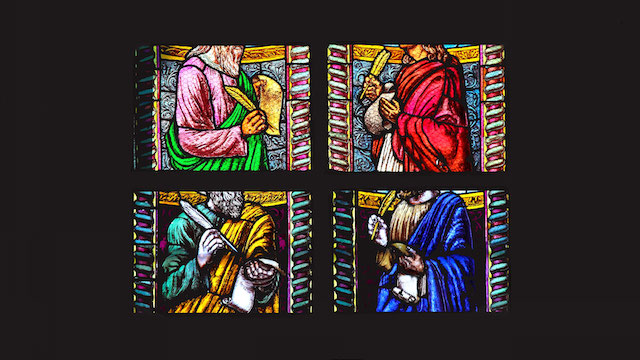Facing Facts
Is The Da Vinci Code based on fact, or are its author’s claims of accuracy the novel’s greatest fiction?
With the US release of the paperback edition in March and the worldwide release of the movie in May, neither Dan Brown’s blockbuster novel nor the controversy surrounding it shows any sign of slowing down. For those who are still wondering what all the fuss is about, we are reprinting, with updates, an article that appeared in the Winter 2005 issue.
Dan Brown, author of the best-selling novel The Da Vinci Code, has created a new genre: the quasi-religious conspiracy-theory thriller with a definite appeal to those of a New Age religious orientation. The international acclaim of Brown’s fiction, which has enjoyed more than three straight years on the New York Times and other best-seller lists, has been further enhanced by the release of a movie based on the book, with Tom Hanks in the starring role, as well as by Brown’s successful defense in the widely publicized lawsuit alleging copyright infringement, brought against him by the authors of a book that he acknowledges as one of his sources.
According to the plot of The Da Vinci Code, the Roman Catholic Church is implicated in a desperate attempt to destroy ancient evidence that proves the Holy Grail is not a cup at all but something so devastating that, if revealed, it would undermine the very foundations of Christendom: the true role of Mary Magdalene. The storyline takes labyrinthine twists as the hero and heroine—pursued by both the police and a shadowy yet powerful religious figure—follow a trail of cryptic ciphers and discover mysterious clues that are visible yet unobserved. The mysterious thread has been cunningly laid, over a period of centuries, inside famous buildings and in the brushstrokes of priceless art.
Yet the greatest enigma of the novel is not in the storyline, compelling as it is. It is the statements presented just before the prologue, under the heading “Fact.” What Brown claims to be factual would, if true, amount to one of the greatest deceptions and cover-ups in history, involving no less than the foundations of mainstream Christianity—particularly Roman Catholicism.
In attempting to bring into focus the often blurred line between fact and fiction in this blockbuster novel, readers should be aware that the author’s own claims of the historical accuracy underpinning his fiction do not stand up to scrutiny.
Fact or Fiction?
Brown states his first “fact” as follows: “The Priory of Sion—a European secret society founded in 1099—is a real organization. In 1975 Paris’s Bibliothèque Nationale discovered parchments known as Les Dossiers Secrets, identifying numerous members of the Priory of Sion, including Sir Isaac Newton, Botticelli, Victor Hugo, and Leonardo da Vinci.”
Fact?
“The Priory of Sion—a European secret society founded in 1099—is a real organization. In 1975 Paris’s Bibliothèque Nationale discovered parchments known as Les Dossiers Secrets, identifying numerous members of the Priory of Sion, including Sir Isaac Newton, Botticelli, Victor Hugo, and Leonardo da Vinci.”
The novel’s plot assigns this secret society the task of preserving the true Holy Grail for nearly a thousand years, and much of the story revolves around tracing clues left by its murdered leader. While these latter elements of the plot are obviously fiction, the authenticity of the parchments is a good test of how seriously we should take this claim of factuality.
The reality is that, although the parchments do feature in a highly publicized 20th-century legend centered in a French village, the entire story has been widely debunked as a hoax. In his book The Truth Behind the Da Vinci Code, for example, Richard Abanes points out that Les Dossiers Secrets are in fact Les Dossiers Secrets d’Henri Lobineau, a 1967 forgery by a con artist named Pierre Plantard, who used the Lobineau pseudonym.
Plantard’s claims were linked to a businessman who purchased the estate of a disgraced priest. As a publicity stunt, the new owner put forward a bizarre story involving the priest and alleged treasure.
Further, although there have been several organizations using the name “Sion,” the notion that there is a secret society by that name dating back to 1099 is pure fiction. Plantard founded the modern Priory of Sion in 1956.
So much for Brown’s first “fact.”
Neither is the second of his three “facts,” regarding Opus Dei, entirely true. Brown asserts that it exists as a “devout Catholic sect.” But Opus Dei is a primarily lay organization within mainstream Catholicism and cannot be described as a sect. Members of Opus Dei are usually part of their local Catholic diocese.
Fact?
“The Vatican prelature known as Opus Dei is a deeply devout Catholic sect. . . .”
In addition, one of the key characters in the novel is portrayed as an “Opus Dei monk.” Opus Dei is not a religious order in the accepted sense, and although it has priests, it has no monks.
Novel Descriptions
Dan Brown’s third “fact” is the most interesting: “All descriptions of artwork, architecture, documents, and secret rituals in this novel are accurate.” In particular, the assertion that his description of documents is accurate does not pass muster. (And one could also take exception with some of his descriptions in the other categories.)
Although Brown never actually claims to be accurate with regard to history, his bold statement regarding “descriptions” and “documents” might disarm the less discerning reader. There are numerous examples of author’s license when it comes to what is claimed to be historical, and here we need to keep in view that The Da Vinci Code is, after all, just a novel. Brown has skillfully woven truth, apparent truth and pure fiction to create a compelling yarn with a distinct feeling of historical authenticity. Even the discerning reader could be forgiven for not always recognizing where fact leaves off and fiction takes over.
A case in point: In order to make his storyline convincing, Brown had to lend credibility to the notion that Christ was not regarded as “God in the flesh” until centuries after His death, and that other gospel accounts rightly contest the validity of those Gospels found in the New Testament. According to the novel, a very human Christ married Mary Magdalene, who bore His child, producing the Merovingian line of European kings. In fact there is not one shred of historical evidence to back these dubious premises. That may not be a problem in a novel, but whether intended or unintended, one result of working such factual-sounding fiction into his story is that for many readers, Brown has cast doubt on the inspiration and veracity of the canon of Scripture.
Fact?
“All descriptions of artwork, architecture, documents, and secret rituals in this novel are accurate.”
Following are just a few of the novel’s questionable claims regarding documents.
Claim: “More than eighty gospels were considered for the New Testament.”
Truth: In his review of The Da Vinci Code, Craig L. Blomberg, professor of the New Testament at Denver Seminary, comments: “Add up everything that was ever called a gospel in the first half-millennium of Christianity . . . and you come up with about two dozen documents. About half of these are known only from quotations in early church fathers or small scraps or fragments that have been discovered, and there is little that is unorthodox in them. Others are clearly Gnostic and equally clearly ‘Christian’ mutations of earlier apostolic tradition” (Denver Journal, Volume 7, 2004).
Blomberg goes on to state that the only noncanonical gospel given any credence at all by scholars is that of Thomas, to which Brown doesn’t even appeal for his plot.
Gospel Truth
Claim: “Jesus’ establishment as ‘the Son of God’ was officially proposed and voted on by the Council of Nicaea. . . . Because Constantine upgraded Jesus’ status almost four centuries after Jesus’ death, thousands of documents already existed chronicling His life as a mortal man. . . . Constantine commissioned and financed a new Bible, which omitted those gospels that spoke of Christ’s human traits and embellished those gospels that made Him godlike.”
Truth: The first statement is a slanted and therefore inaccurate version of a decision
of the Council of Nicea. Further, the number of nonbiblical citations we know of that refer to Christ, or someone who may have been Christ, can be numbered on the fingers of one hand. One is a brief mention by Josephus, the first-century Jewish historian. In reality, the reverse of Brown’s claim is true: the evidence points to an amazingly early acceptance of the divinity of Christ among believers. For example, the four Gospels accepted as canonical, Matthew, Mark, Luke and John, were viewed as such long before Constantine, as second-century documents attest.
It can also be argued effectively that the early appearance of the canonical Gospels, and their acceptance among believers, made secular accounts of Christ’s life unnecessary and redundant. The number of early citations from the Gospels is massive. As early as the beginning of the second century, church fathers such as Ignatius of Antioch, Polycarp, Justin Martyr, Clement of Alexandria and Irenaeus were widely quoting from and/or paraphrasing the Gospel accounts and the Epistles in their own writings. There are even references in the New Testament indicating that some of the apostolic writings had begun to be viewed as sacred during the lifetime of the apostles themselves.
Early Evidence
It is helpful to consider some internal evidence regarding how early the canon of the New Testament began to come together. In his second letter, the apostle Peter already equated at least some of Paul’s epistles with Scripture: “Therefore, beloved, . . . consider that the longsuffering of our Lord is salvation—as also our beloved brother Paul, according to the wisdom given to him, has written to you, as also in all his epistles, speaking in them of these things, in which are some things hard to understand, which untaught and unstable people twist to their own destruction, as they do also the rest of the Scriptures” (2 Peter 3:14–16, emphasis added).
Toward the end of his life, in what appear to be Paul’s final instructions to the evangelist Timothy from a prison cell in Rome, the apostle wrote: “Bring the cloak that I left with Carpus at Troas when you come—and the books, especially the parchments” (2 Timothy 4:13). We do not know what these parchments contained, but in those days of difficult travel Paul would not have asked Timothy to add that weight to his baggage unless they were very important. In light of the intriguing passage from 2 Peter, perhaps here is an indication that the canon of the New Testament was in the making before the deaths of the apostles who had personally known Christ.
If Scripture is given by inspiration of God (2 Timothy 3:16), does it make sense to believe that He would have left the selection of writings to later chance or committees, after the witnesses to Christ’s resurrection and the original disciples were all in their graves?
History shows that those through whom the Eastern Orthodox and Roman Catholic Churches trace their descent concurred as to which Gospels were to be included in the New Testament. It would have been impossible for Constantine to eradicate all copies of the New Testament, particularly outside his own jurisdiction, and there is no evidence that he tried.
Then there is Brown’s statement that the four canonical Gospel accounts of Jesus’ life are embellished accounts that “made Him godlike” as opposed to speaking of His “human traits.” In fact, those four accounts describe Him as weeping, showing compassion and empathy, becoming angry, suffering pain and hunger, being troubled as He contemplates His impending crucifixion, and expressing other human emotions. On the other hand, the Gnostic gospels of Mary and Philip, from which Brown’s characters quote to help make their case, survive as scarcely more than a collection of sayings. They contain little or no detail of any sort regarding Jesus’ life. So again, the reverse of what Brown writes is actually true.
The Dead Sea Gospel?
Claim: “Some of the gospels that Constantine attempted to eradicate managed to survive. The Dead Sea Scrolls were found in the 1950s.”
Truth: The Dead Sea Scrolls are Jewish documents found in the 1940s and early ’50s. They include some very valuable Hebrew, Aramaic and Greek versions of parts of the Old Testament that accord remarkably with other manuscripts, but they contain nothing specifically relating to the later New Testament Gospels or the life of Christ.
We could go on, but this should suffice to alert the reader to the blurring of fact and fiction in The Da Vinci Code. More complete analysis of the numerous liberties the novel takes can be found in a number of books on the subject. We’ve reviewed five of them in “The Da Vinci Con.”
Dan Brown is a gifted creator of convincing stories. But much of The Da Vinci Code’s popularity is in the chord it strikes with our religiously lightweight and capricious New Age, where individuals can pick and mix their own personal brand of religious karma. We live in a culture of “spirituality lite,” where we are fascinated with “spiritual” issues that titillate us, yet are repelled by those that require deep commitment to a high moral standard. Religion, history, God and everything else is thus reconstructed until it fits into our feel-good, own-brand comfort zones.
So let’s not lay all the blame for the spreading of doubtful religious and historical “facts” on Dan Brown or his novel. A ready market was eagerly waiting.




